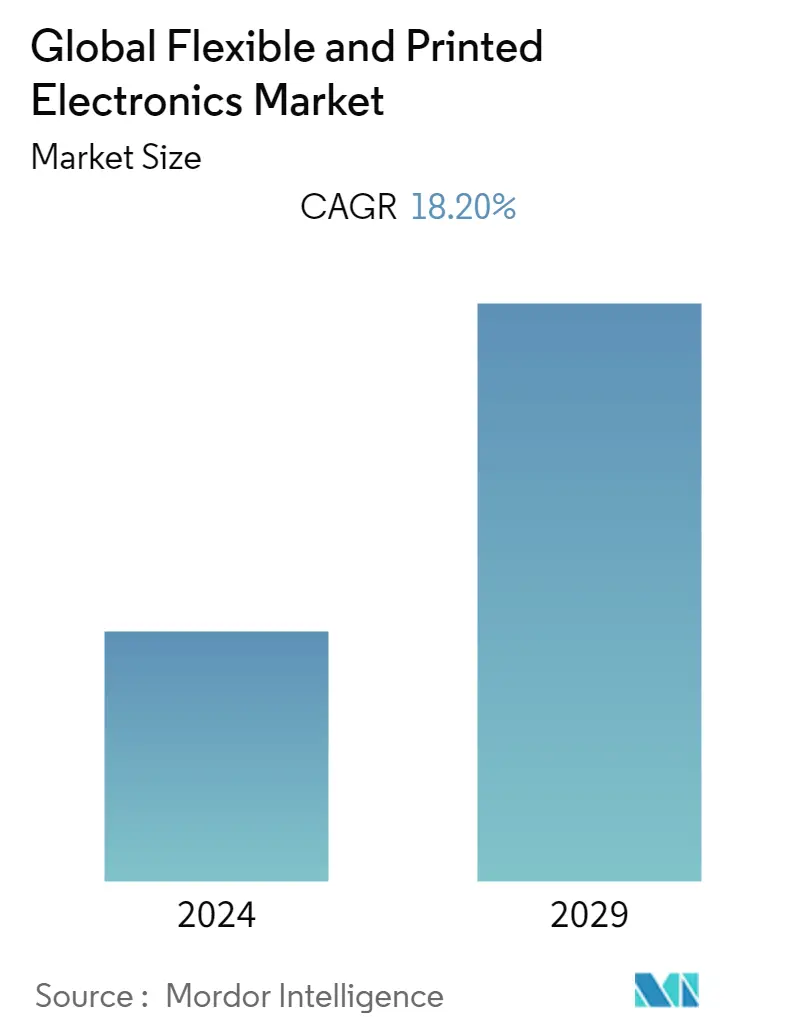Market Size of Global Flexible and Printed Electronics Industry

| Study Period | 2019 - 2029 |
| Base Year For Estimation | 2023 |
| CAGR | 18.20 % |
| Fastest Growing Market | North America |
| Largest Market | Asia-Pacific |
| Market Concentration | Medium |
Major Players
*Disclaimer: Major Players sorted in no particular order |
Need a report that reflects how COVID-19 has impacted this market and its growth?
Flexible & Printed Electronics Market Analysis
The global Flexible and Printed Electronics Market is expected to register a CAGR of 18.2% during 2022-2027. The market is primarily driven by the rapid penetration of smart wearable and integrated electronic devices that have increased demand for advanced intelligent systems with high performance, micro size, mechanical flexibility, and high-temperature stability for use as flexible and stretchable displays, personal health monitoring, human motion capturing, smart textiles, electronic skins, and other applications.
- Electronics players in the market, such as Samsung and LG Electronics, have introduced the flexible, foldable, and rollable smartphone, display, and tablet products. Because of the rapidly aging global population and the dramatically increasing demand for in-home healthcare, wearable and mobile health monitoring technologies have recently sparked tremendous interest worldwide.
- According to BNP Media, electronic components will account for 50% of an automobile's total production cost by 2030. Earlier in the decade, it was only 30%. Thin, light, and flexible electronics advancements are driving various innovative technologies, from curved TVs to glucose-monitoring contact lenses. This could result in the development of printable solar cells and flexible screens based on organic light-emitting diodes (OLEDs).
- The electronics industry is rapidly transitioning from standard, rigid form factors to stretchable and conformable devices. Wearables for healthcare, smart packaging, sensors, automotive taillights and displays, flexible displays, photovoltaics, and other printed, flexible, and stretchable electronics products are increasing weekly.
- Furthermore, in-mold electronics (IME) and flexible sensors are expanding the application of flexible and printed electronics in smart wearable technologies. Wearable device growth, particularly smart wearable device growth, may broaden the market scope over the forecast period. Cisco predicts that the number of connected wearables will exceed 1,105 million by 2021.
- COVID-19's emergence and expansion have significantly impacted the company's position in the flexible electronics and electronics value chain. On the other hand, the market for flexible electronics has declined significantly due to global shutdowns that have resulted in the complete closure of all public places, industrial facilities, and offices.
- The COVID-19 outbreak caused major delays for electronic manufacturers, as Chinese suppliers have struggled to keep factories running at full capacity. Many electronic manufacturers in the United States and Europe rely on components manufactured in China. In February, IPC, an electronic equipment trade organization, surveyed 65% of the 150 electronic manufacturers and suppliers who participated and reported supplier delays due to the spread of COVID-19.
